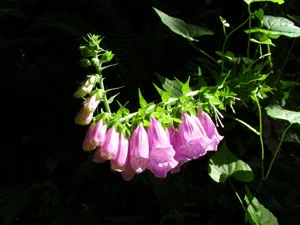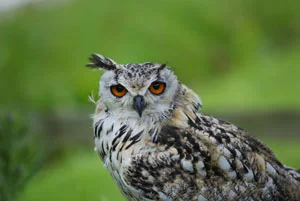 24th June 2009
24th June 2009Midsummer and the swifts are soaring above the lane by the Coach and Horses.The vegetation either side of the Peppercombe trail is now at its fullest. At the start of the track the hedge is at least seven foot high with black bryony, flowering dog roses and honeysuckle climbing upwards through the leafy hedgerow. The verges now crammed with massive hogweed, thistle, red campion, foxgloves and sorrel spiking up from low lying buttercups and clover. The leaves on the ancient trees are now fully formed creating a canopy over the valley. Compared to Springtime the trail down is now in shade except for the occasional sunlit patches where wonky foxgloves bend over instead of upwards probing for the light. The massive fungus, pictured, was high up in an ivy clad tree. By the pink cottage rhododendrons are in flower but the stream by the bridge has all but dried up. Further on down past the old stables, the huge bank by the wooden bungalow is now full of ferns. This area was carpeted by primroses in March and April followed by bluebells in May. In the past donkeys and ponies have grazed in the upper and lower meadows and this year’s summer visitors, the Belted Galloway cattle, have settled into Peppercombe Meadows, under the coast path. Pathways and glades are opened up as a result of them grazing allowing a much greater range of grasses and wild flowers to emerge in Spring and Summer. The dung left behind benefits
 beetles and other insects which in turn provides a source of food for birds. The cattle were chosen because they are extremely hardy and have a “generally docile nature”. While I was there they didn’t lift their heads up and continued grazing quietly so keep to the path and they won’t even notice you. Read the sign, keep dogs on the lead and shut the gate. Ferns seem to be in abundance at the further end by the steps but the rest as usual full of wild flowers and grasses. In earlier years this site had a large number of big old gorse bushes which were home to many spiders. I arrived down at the beach in glorious sunshine and was greeted by a couple of blokes sitting on the cobbles who, on seeing the camera, pointed out a seal bobbing off-shore. The black blob didn
beetles and other insects which in turn provides a source of food for birds. The cattle were chosen because they are extremely hardy and have a “generally docile nature”. While I was there they didn’t lift their heads up and continued grazing quietly so keep to the path and they won’t even notice you. Read the sign, keep dogs on the lead and shut the gate. Ferns seem to be in abundance at the further end by the steps but the rest as usual full of wild flowers and grasses. In earlier years this site had a large number of big old gorse bushes which were home to many spiders. I arrived down at the beach in glorious sunshine and was greeted by a couple of blokes sitting on the cobbles who, on seeing the camera, pointed out a seal bobbing off-shore. The black blob didn ’t hang around. The only other life forms were three gulls and the elderly couple I had spoken to earlier who were on their way to Portledge the hard way. After a very slow descent down the steep cliff path they now began to traverse the cobbles, explorer style, with walking poles. In contrast a more nimble pair scampered down with nets aloft ready for shrimping. Clear blue sky and still blue sea so there was excellent light over Clovelly and Hartland Point to the left and Portledge meadows above the red cliffs to the right. Beyond Portledge the South West Coastal Path leads to Abbotsham Cliffs and Westward Ho!. Below the path, the lower cliff is clad in heather with new shoots so this will make for a colourful August. I have been taken photographs of Peppercombe Beach, Peppercombe Valley and its wild flowers for many years so please visit my web site to see more Peppercombe Seasons. There is a good hike along the South West Coast Path from Peppercombe to Bucks Mills. The most colourful time for this in May when the woods are full of bluebells. Photos copyright Pat Adams
’t hang around. The only other life forms were three gulls and the elderly couple I had spoken to earlier who were on their way to Portledge the hard way. After a very slow descent down the steep cliff path they now began to traverse the cobbles, explorer style, with walking poles. In contrast a more nimble pair scampered down with nets aloft ready for shrimping. Clear blue sky and still blue sea so there was excellent light over Clovelly and Hartland Point to the left and Portledge meadows above the red cliffs to the right. Beyond Portledge the South West Coastal Path leads to Abbotsham Cliffs and Westward Ho!. Below the path, the lower cliff is clad in heather with new shoots so this will make for a colourful August. I have been taken photographs of Peppercombe Beach, Peppercombe Valley and its wild flowers for many years so please visit my web site to see more Peppercombe Seasons. There is a good hike along the South West Coast Path from Peppercombe to Bucks Mills. The most colourful time for this in May when the woods are full of bluebells. Photos copyright Pat Adams



